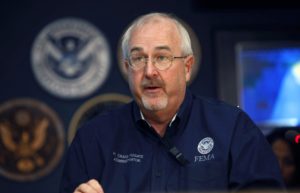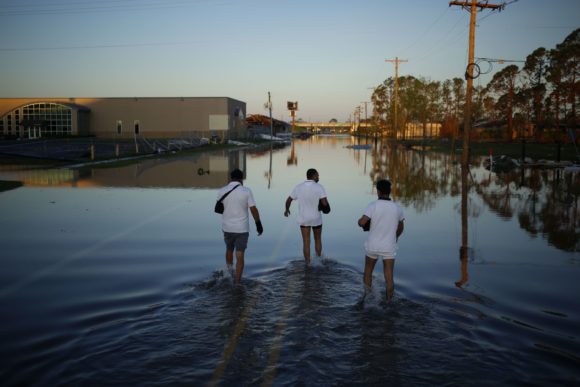Perhaps no single federal agency has been tested as much by 2020 as the Federal Emergency Management Agency.
It has been a year of disaster. In addition to Covid-19, it was the busiest Atlantic hurricane season on record, and wildfires in California have consumed 4.1 million acres (another record) and are still blazing in December.
All in all, the agency had to staff 125 official declarations of emergencies — up from 15 in 2019. And internal reports and those from the General Accounting Office showed the agency’s staff and resources were already stretched before 2020.
The Biden administration has asked Craig Fugate, who headed the agency under President Barack Obama, to look at what reforms are needed to strengthen the battered agency and the nation’s emergency preparedness capabilities in general. Fugate declined to talk about what those might be. In discussion last April, however, he said emergency management personnel at federal, state and local levels needed to prepare for emergencies to worsen over the years because of climate change. “FEMA is constantly evaluating lessons from recent disaster activity and adjusting long-term disaster staffing needs accordingly,” a FEMA spokesman said in an email.

There are plenty of FEMA watchers who have opinions on what new officials should prioritize and one of them, Rob Moore, a senior policy analyst for the Natural Resources Defense Council, has joined with a group of other non-profits and emergency management professionals to pull together a list of recommendations for the transition. Moore and these other experts think the new administration should start with some steps that don’t require Congressional approval.
One of FEMA’s main responsibilities (or burdens) is to maintain the National Flood Insurance Program, which is by all accounts very broken. Almost 95 percent of flood insurance in America is through the federal government. FEMA draws flood-risk zones and insures those within it. By the estimate of one private group, they have underestimated the homes at severe risk of flooding by roughly 6 million. Yet even so, as hurricane seasons have intensified, FEMA is shelling out far more for rebuilding in flooded areas than it can afford.
Obama passed an executive order that demanded that every federal dollar spent to rebuild public housing, facilities or infrastructure had to be built back with a margin of safety above the most recent flood level. Forcing recipients of federal money to build new homes that meet tougher standards would save money when the next storm inevitably hits.
He also required that coastal properties accepting federal money factor in sea-level rise. A week before Hurricane Harvey hit in 2017 and submerged Houston in a record-shattering 60 inches of rain, Trump rescinded the order. Biden needs to bring it back, Moore says.
The last time the agency updated the requirements for homes inside severe flood zones to receive federal flood insurance was when Jimmy Carter was president. Currently, regulations only require homes in those zones to build above the 100-year flood level – but just. Even by one millimeter is good enough.
But with storms intensifying, Moore asks, “Is it the time for us to put behind us the 100-year flood plain as the benchmark for flood risk?” FEMA, he points out, could require that homes in these areas are at least two feet above the 100 year flood level, or they could require that they build to the 500-year flood level.
Beyond shoring up the flood program, FEMA also needs to bolster its own resources — namely its staff. Currently, they have a force-strength (their word for personnel fielded to manage national incidents) of 11,000. That’s 6,000 short of its ideal force strength of 17,000. The agency says it is hiring rapidly and expects to meet that benchmark by 2024.
But that requires money from Congress and the outlook for that at the currently moment is, well, murky— to say the least.
Still, Moore says he doesn’t like to think of what might have if the nation doesn’t face the realities of escalating crises due to climate change: “Our emergency management capacity is closer to empty than to full.”
About the photo: People walk down a flooded street after Hurricane Delta made landfall in Lake Charles, Louisiana, U.S., on Saturday, Oct. 10, 2020. Delta weakened to a tropical depression as it moved inland over northeastern Louisiana, knocking out power lines and drenching an area still recovering from the onslaught of Hurricane Laura.
Was this article valuable?
Here are more articles you may enjoy.


 Inspections of Affected Barrels Will Take Time as Flood Cleanup Progresses at Kentucky Distillery
Inspections of Affected Barrels Will Take Time as Flood Cleanup Progresses at Kentucky Distillery  LA Wildfires Had Little Impact on Reinsurer Risk Appetite During April Renewals
LA Wildfires Had Little Impact on Reinsurer Risk Appetite During April Renewals  Tariffs Threaten to Push US Home Insurance Rates Even Higher
Tariffs Threaten to Push US Home Insurance Rates Even Higher  In Fight Over Insurance, Neighbors Crowdsource LA Fire Contamination Data
In Fight Over Insurance, Neighbors Crowdsource LA Fire Contamination Data 